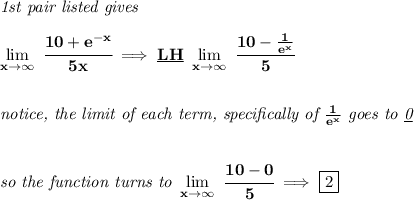let's check these folks using
LH, or L'Hopital rule, since they're indeterminate types.

on this pair, the denominator is moving faster than the numerator, and thus, yielding a much larger denominator on every iteration, moving towards a limit of 0.
![\bf \textit{3rd pair listed gives }\\\\ \lim\limits_(x\to \infty)\ \cfrac{[ln(x)]^3}{x}\implies \underline{LH}\ \lim\limits_(x\to \infty)\ \cfrac{3ln(x)\cfrac{1}{x}}{1}\implies \lim\limits_(x\to \infty)\ \cfrac{3ln(x)}{x}](https://img.qammunity.org/2018/formulas/mathematics/high-school/6kl6jzkfxk1w0igxf1l9diobebmjc9b4yg.png)
on this pair, the denominator, again, is moving faster, since ln() results in an exponent for the constant "e", and thus is a much smaller then the denominator on every iteration, thus, the denominator gets much larger and moving towards 0 as limit as well.

on this pair, the numerator is just a constant, thus is static, and the denominator is moving onwards on every iteration, thus moving also again towards 0.
now, let's take a peek of the 1st pair for f(x) and g(x)
